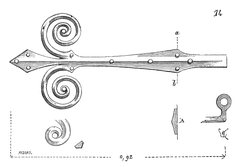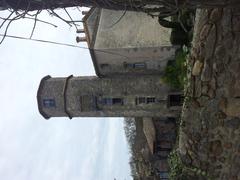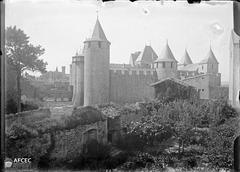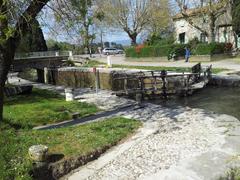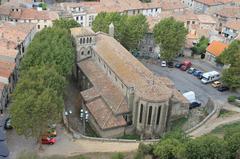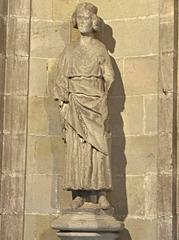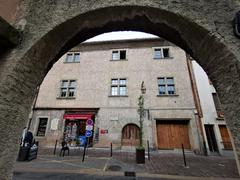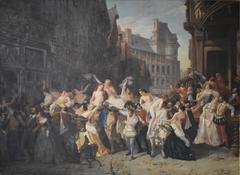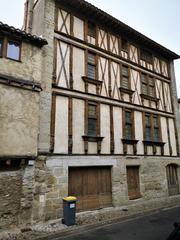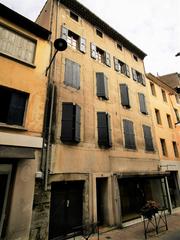Visiting the Manufacture Royale de Draps in Carcassonne and Villeneuvette: The Complete Guide to France’s Royal Textile Heritage
Date: 14/06/2025
Introduction
The Manufacture Royale de Draps, with locations in both Villeneuvette and Carcassonne, is an exceptional testament to France’s early industrial ambitions and royal economic reforms. Established under King Louis XIV and Jean-Baptiste Colbert in the late 17th century, these sites not only catalyzed the French textile industry but also fostered pioneering social models through their worker villages and integrated urban planning (Hérault Tourisme; POP: Plateforme ouverte du patrimoine). Today, visitors can immerse themselves in a unique blend of industrial archaeology, architecture, and social history, making the Manufacture Royale de Draps a must-see destination for cultural travelers and history enthusiasts alike.
Table of Contents
- Introduction
- Origins and Foundation
- Architectural and Urban Development
- Industrial Operations and Economic Impact
- Social Structure and Daily Life
- Evolution Through the Centuries
- Preservation and Heritage Status
- Cultural Significance and Legacy
- Key Dates and Milestones
- Practical Visitor Information
- Frequently Asked Questions (FAQ)
- Conclusion
- Call to Action
I. Villeneuvette: A Model Industrial Village
Origins and Foundation
The Manufacture Royale de Draps at Villeneuvette was established in 1677 as part of Colbert’s strategy to develop French industry and ensure national self-sufficiency. The village was intentionally built around the factory, with the Dourbie River providing essential water power and transportation (Hérault Tourisme).
Architectural and Urban Development
Villeneuvette’s urban plan reflects 17th-century ideals: a central factory complex surrounded by rows of workers’ houses, communal amenities, and a monumental gateway inscribed “Honneur au Travail.” The use of local stone and symmetrical layouts fostered both community spirit and efficiency.
Industrial Operations and Economic Impact
The factory specialized in high-quality woolen cloth, serving the French army and export markets. Strict quality controls and royal inspections ensured reputation and profitability, while ancillary trades such as sheep farming and dye production flourished locally.
Social Structure and Daily Life
Life in Villeneuvette was shaped by a paternalistic regime: the company provided housing, education, and social services, but also imposed strict rules and a clear hierarchy. Despite these controls, the shared experience created a strong community identity.
Evolution and Preservation
After prospering in the 18th century, Villeneuvette faced decline with the advent of mechanized industry and changes in fashion. The manufacture ceased operations in the early 20th century. Recognizing its heritage value, Villeneuvette was designated a Monument Historique in 1995, with its urban fabric and buildings largely intact (Hérault Tourisme).
Visiting Villeneuvette
- Hours: Open year-round; free access.
- Guided Tours: Available (mainly in French) on weekends and holidays—see Hérault Tourisme for schedules.
- Accessibility: Wheelchair-friendly; paved paths.
- Nearby: Haut-Languedoc Regional Natural Park, Canal du Midi, Carcassonne.
- Tips: Visit the monumental gateway and preserved communal spaces for photography, and check for seasonal heritage events.
II. Carcassonne: The Manufacture Royale de Draps de la Trivalle
Historical Setting and Architectural Features
Founded in 1694 by Guillaume Castanier, Carcassonne’s Manufacture Royale de Draps became a regional industrial powerhouse, employing up to 2,000 workers at its peak and producing cloth exported as far as the Levant (POP: Plateforme ouverte du patrimoine; Wikipedia: Manufacture de draps des Saptes). The main building features a classical 18th-century façade with a “basket-handle” arch, elegant stonework, and a grand staircase symbolizing the city’s industrial pride.
Site Layout and Location
Strategically located at 1 Rue Flandres Dunkerque/77 Rue Trivalle, on the right bank of the Aude River and at the foot of Pont-Vieux, the manufacture leveraged water access for textile processing and transport (Monumentum). Its proximity to the Bastide Saint-Louis and the medieval Cité made it an integral part of Carcassonne’s urban and economic fabric.
Cultural and Economic Impact
The manufacture’s success spurred the development of the Bastide Saint-Louis, with merchants building grand hôtels particuliers. Carcassonne’s textile reputation was protected by strict production regulations and royal privileges, ensuring the city’s prosperity and influence (Carcassonne Tourisme).
Heritage and Visitor Experience
Though no longer a working factory, the Manufacture Royale de Draps is preserved as an important monument. Interior access is generally limited due to its use as municipal offices, but the exterior is accessible and forms a highlight of heritage tours. The adjacent Maison de la Laine et du Drap, opened in June 2024, offers interactive exhibits, demonstrations, and step-by-step displays covering the entire textile production process (ADT Aude Tourisme).
Visiting Information
- Ancienne Manufacture Royale de Draps:
- Exterior viewing is free and possible at any time.
- Interior access: Monday–Friday, 8:30 am–12:30 pm & 1:30 pm–5:30 pm (Fridays until 4:00 pm), subject to municipal operations.
- Special access: During European Heritage Days (Monumentum JEP).
- Maison de la Laine et du Drap:
- 77 Rue Trivalle; entry from €2.
- Live demonstrations and historical exhibits.
- Guided Tours:
- Offered via Carcassonne Tourist Office; recommended for in-depth exploration (Tourisme Carcassonne).
- Accessibility:
- Flat pavements and nearby public parking; interior accessibility may be limited.
- Facilities:
- Restrooms and amenities available in the Trivalle district.
- Photography:
- Exterior photography welcome; interior subject to restrictions.
Events and Special Experiences
- European Heritage Days (September): Interior tours, workshops, and cultural events.
- Family-Friendly Tours: Interactive and educational, available through the Maison de la Laine et du Drap.
III. Key Dates and Milestones
- 1677: Manufacture chartered in Villeneuvette.
- 1694: Carcassonne’s Manufacture Royale de Draps founded.
- 18th century: Period of peak production and influence.
- 1790s: French Revolution leads to privatization.
- 19th century: Decline with industrial modernization.
- Early 20th century: Closure of Villeneuvette factory.
- 1995: Villeneuvette designated a Monument Historique.
- 2024: Maison de la Laine et du Drap opens in Carcassonne.
IV. Frequently Asked Questions (FAQ)
Q: What are the visiting hours at Villeneuvette?
A: Open year-round for free outdoor exploration; guided tours offered on weekends and holidays.
Q: Is the Carcassonne Manufacture open for visits?
A: Exterior accessible at all times; limited interior access during administrative hours and special events.
Q: Are tickets required?
A: Exterior visits are free. Maison de la Laine et du Drap charges a small fee.
Q: Is the site accessible to people with disabilities?
A: Exteriors and public areas are accessible; check with sites for specific accommodations.
Q: How can I book a guided tour?
A: Through Carcassonne Tourist Office or Hérault Tourisme.
Q: What else should I see nearby?
A: Bastide Saint-Louis, Pont-Vieux, medieval Cité, Maison de la Laine et du Drap, Canal du Midi.
V. Summary and Final Tips
The Manufacture Royale de Draps in both Villeneuvette and Carcassonne encapsulates centuries of industrial, architectural, and social innovation. From the model worker village and monumental gate of Villeneuvette to the elegant classical façades of Carcassonne’s factory, these sites offer a vivid journey through France’s economic and cultural evolution. Today, they are celebrated as protected monuments, educational centers, and focal points for heritage tourism, with comprehensive visitor services and engaging exhibitions.
For an optimal visit:
- Check event calendars for special interior access and workshops.
- Use digital resources and the Audiala app for guided experiences.
- Combine your trip with a tour of Carcassonne’s medieval Cité and Bastide Saint-Louis for a full immersion in the region’s layered history.
VI. Call to Action
For the latest updates, ticketing, and special events, consult the Carcassonne Tourism Office and Hérault Tourisme. Enhance your experience by downloading the Audiala app for interactive heritage tours. Follow local social media and related articles for more insights into Carcassonne and Hérault’s historical sites.
Contact Information
- Maison de la Laine et du Drap: 77 Rue Trivalle, Carcassonne. Tel: +33 4 68 11 66 00 (ADT Aude Tourisme)
- Carcassonne Tourist Office: 28 Rue de Verdun, Carcassonne. Tel: +33 4 68 10 24 30 (Tourisme Carcassonne)
Visuals and Media
Image: The elegant 18th-century façade of the Ancienne Manufacture Royale de Draps, a key historical site in Carcassonne.
Image: Interactive exhibits at the Maison de la Laine et du Drap, illustrating traditional wool processing techniques.
Explore interactive map of Carcassonne historical sites
Virtual tour of the Ancienne Manufacture Royale de Draps
Internal Links
- Explore Carcassonne’s Bastide Saint-Louis: Architectural Highlights
- Guide to La Cité de Carcassonne: UNESCO World Heritage Site
- Top Historical Sites in Carcassonne: A Visitor’s Guide
References
- Hérault Tourisme: Villeneuvette Manufacture Royale de Draps
- POP: Plateforme ouverte du patrimoine
- Wikipedia: Manufacture de draps des Saptes
- Carcassonne Tourism Official Site
- Musique et Patrimoine de Carcassonne Blog
- Monumentum: Ancienne Manufacture Royale de Draps
- ADT Aude Tourisme: Maison de la Laine et du Drap
- Navaway Carcassonne Heritage Routes

